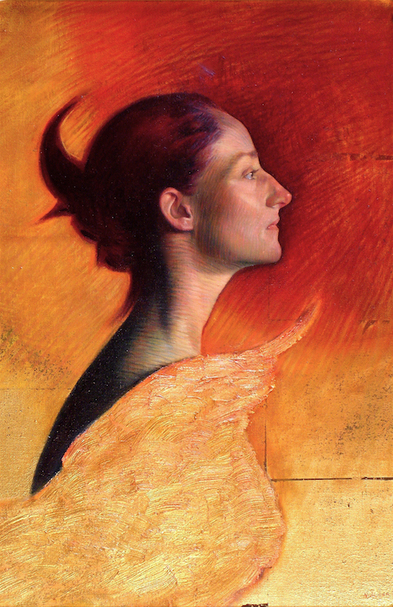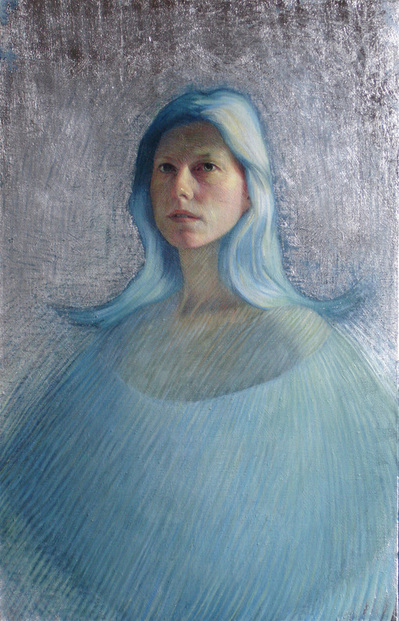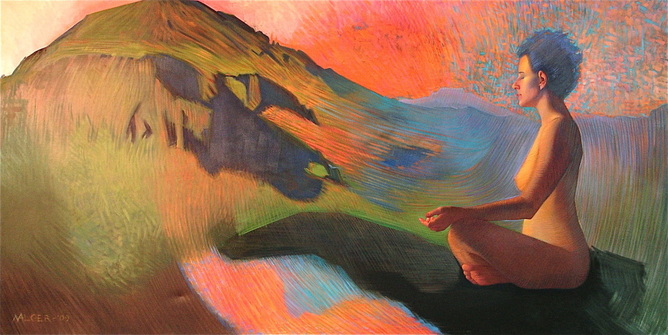INTERVIEW WITH NICOLE ALGER
S&A: Thank you, Nicole, for participating in this interview. One of the striking qualities of your work is the manner in which you apply scintillating color throughout a painting, which is especially apparent in your Mythology series and Portraiture. Could you tell us a little bit about your color decision process? In your usage, does color function primarily as a subjective response to the subject matter/idea or are there colors which correspond to specific meanings in some of your paintings?
NA: The color choices for Diana and Daedala are straighforward: hot colors for the female Daedalus and the cool colors for the lunar Diana. The imperfectly applied gold and silver leaf is a nod to the divinity in our humanness and the humanness in our concepts of divinity. Amplifying the color is another way to abstract the image, however I use them subjectively as well. The gold and silver leaf is a nod to iconic paintings, an element that further abstracts the image. I want there to be enough separation from reality such that the viewer doesn't see just a portrait; I objectify my portraits and personify my still lifes in my desire to create beauty.
NA: The color choices for Diana and Daedala are straighforward: hot colors for the female Daedalus and the cool colors for the lunar Diana. The imperfectly applied gold and silver leaf is a nod to the divinity in our humanness and the humanness in our concepts of divinity. Amplifying the color is another way to abstract the image, however I use them subjectively as well. The gold and silver leaf is a nod to iconic paintings, an element that further abstracts the image. I want there to be enough separation from reality such that the viewer doesn't see just a portrait; I objectify my portraits and personify my still lifes in my desire to create beauty.
Daedala. Oil and gold leaf on canvas; 71.1 x 45.7 cm (28″ x 18″).
Diana. Oil and silver leaf on canvas; 71.1 x 45.7 cm (28″ x 18″).
S&A: You wrote that you use “...the language of the chakra system” in your art. How do you translate this facet of Eastern philosophy into your paintings?
NA: A primer on the chakras: we have seven energetic centers, or wheels, and each represents different facets of our mind/body/spirit. Each wheel has a representative color as well. With that in mind, it is a perfect modality for expressing emotions with paint. I use that modality loosely and feel my way around a color to see if it elicits what I want to convey.
S&A: What role does your familiarity with other cultures play in the conception of your work? For example, are you inspired by particular elements in Eastern manuscript paintings or Thangka paintings?
NA: I look at compositional and spiritual elements in the work of the world. Thangka paintings do not move me, so I would not say they inspire me despite the intention behind them. I am interested in work that conjures reverence in me. Animist based work tends to strike that chord.
S&A: In Aspiration, a woman is immersed in contemplation. The energetic mark making seems to correspond to the vitality of her ‘subtle body,’ and it also gives the impression that behind the veil of stillness there exists surging activity in the surrounding environment. The vertical strokes of color about her head are evocative of an uplifting experience while the mountain in the upper left quadrant has an upward pulling effect. What inspired this painting? Was it your own experience with meditation that informed the work? What is the relationship between the woman and her environment?
NA: Along with some chakra magic, this image is directly inspired by the Zen proverb that insists we live each day as if our hair was on fire. Her hair is violet, the color of the crown chakra, where all light and divinity pour through. Here, she is internally on fire, naked, and in tune with the energy of her surroundings. An animist fantasy. Aspiration shows her enlightened in a corporeal and mystical sense. And how better to feel and breathe in the majesty of the cosmos than atop a mountain by the rising sun?
NA: A primer on the chakras: we have seven energetic centers, or wheels, and each represents different facets of our mind/body/spirit. Each wheel has a representative color as well. With that in mind, it is a perfect modality for expressing emotions with paint. I use that modality loosely and feel my way around a color to see if it elicits what I want to convey.
S&A: What role does your familiarity with other cultures play in the conception of your work? For example, are you inspired by particular elements in Eastern manuscript paintings or Thangka paintings?
NA: I look at compositional and spiritual elements in the work of the world. Thangka paintings do not move me, so I would not say they inspire me despite the intention behind them. I am interested in work that conjures reverence in me. Animist based work tends to strike that chord.
S&A: In Aspiration, a woman is immersed in contemplation. The energetic mark making seems to correspond to the vitality of her ‘subtle body,’ and it also gives the impression that behind the veil of stillness there exists surging activity in the surrounding environment. The vertical strokes of color about her head are evocative of an uplifting experience while the mountain in the upper left quadrant has an upward pulling effect. What inspired this painting? Was it your own experience with meditation that informed the work? What is the relationship between the woman and her environment?
NA: Along with some chakra magic, this image is directly inspired by the Zen proverb that insists we live each day as if our hair was on fire. Her hair is violet, the color of the crown chakra, where all light and divinity pour through. Here, she is internally on fire, naked, and in tune with the energy of her surroundings. An animist fantasy. Aspiration shows her enlightened in a corporeal and mystical sense. And how better to feel and breathe in the majesty of the cosmos than atop a mountain by the rising sun?
Aspiration. Oil on canvas; 91.4 x 182.8 cm (36″ x 72″).
S&A: Red Sun and Spectrum are examples of what could be described as visionary artworks, where a strong cognizance of the spiritual aspect of human nature is felt. In such works, inner and external realities seem to coalesce into a unique and joyful vision. Would you be willing to share the personal and/or formal meaning behind Red Sun and Spectrum?
NA: Red Sun was the painting that ushered in my personal style. I had decided to answer the Big Question: what is worth painting? I landed where most creatives arrive if they have been doing it long enough: I let my gut lead the way. It was antithetical to my training but I had to jump. It was a long and fairly depressing period, with endless, unclear moments, but I understood that the work had to be approached indirectly and not planned in advance. I did not overplay the composition. I started with one dominant feature and worked outwardly. I wanted the image to reveal itself to me. The color aspect was reflective of my fascination with the chakra system and how each color represents different facets of our lives. Red Sun expresses ultimate exuberance. I wanted to show the full force of an open channeled human being, totally awake, nothing energetically blocked. Spectrum is another full throttle image. I am deeply affected and inspired by Japanese paintings, additionally by Buddhist wisdom. I find inspiration all over the place, and as often from the written word and film.
S&A: Diana is a work you painted on silver leaf. Does the painting represent the goddess Diana from Roman mythology? Her hair tapers into a design whose shape is reminiscent of two crescent moons, signifying the traditional attribute of the goddess. What personal significance does the archetype of Diana have for you?
NA: I was inspired by a friend to paint her as Diana, the Roman goddess. Depicting mythological figures and archetypes are a perfect way to express strong feelings and impressions of people. I like all the stronger goddesses, aside from Juno who was hopelessly envious. Diana, as goddess of moon, the hunt, and protector of many, is one of my favorites and a great model not only for grrl power, but also of the Venusian virtues.
S&A: You manage to balance classical training with imagination very successfully. How did you transition from naturalistic painting to a method of painting more inclusive of the spirit/imagination?
NA: The drive to push beyond what I thought I knew was always strong and grew stronger over the years. I had a seminal moment that I cannot explain, but I quite literally walked into my studio one day, and told the portrait I was working on—-yes, I talk to myself, my plants, and my paintings—that it was time to ‘pump it up’. And with that, my application and color choices expanded quickly. As I mentioned before, for some years, I had been asking myself what was worth painting and what I was here to try and do. I chose to trust my instincts and have them guide me. It’s been very challenging, exhilarating, and helpful in unlocking what we creative types call my ‘voice’.
S&A: Is there anything you are working on or have planned for the near future that you would be inclined to share with us?
NA: My latest paintings are inspired by the profound duet that indigenous folk have with their environment. Abstracted man in abstracted nature, suggesting remembrance of communion with the physical world. Remembrance is the operative word. One writer of a current political drama recently said that what he really writes about is power, that life is political because it is transactional and that art is successful when it reveals what we already know. That suggests peeling back a veil to highlight something lost, hidden, or forgotten. In the words of another painter, I also paint what is missing, and that is also suggestive of remembrance. I want to explore those aspects of modern life that are lacking, most of all the interplay with the environment as our source and our compadre.
See more artwork by Nicole Alger at her website: http://www.nicolealger.com
NA: Red Sun was the painting that ushered in my personal style. I had decided to answer the Big Question: what is worth painting? I landed where most creatives arrive if they have been doing it long enough: I let my gut lead the way. It was antithetical to my training but I had to jump. It was a long and fairly depressing period, with endless, unclear moments, but I understood that the work had to be approached indirectly and not planned in advance. I did not overplay the composition. I started with one dominant feature and worked outwardly. I wanted the image to reveal itself to me. The color aspect was reflective of my fascination with the chakra system and how each color represents different facets of our lives. Red Sun expresses ultimate exuberance. I wanted to show the full force of an open channeled human being, totally awake, nothing energetically blocked. Spectrum is another full throttle image. I am deeply affected and inspired by Japanese paintings, additionally by Buddhist wisdom. I find inspiration all over the place, and as often from the written word and film.
S&A: Diana is a work you painted on silver leaf. Does the painting represent the goddess Diana from Roman mythology? Her hair tapers into a design whose shape is reminiscent of two crescent moons, signifying the traditional attribute of the goddess. What personal significance does the archetype of Diana have for you?
NA: I was inspired by a friend to paint her as Diana, the Roman goddess. Depicting mythological figures and archetypes are a perfect way to express strong feelings and impressions of people. I like all the stronger goddesses, aside from Juno who was hopelessly envious. Diana, as goddess of moon, the hunt, and protector of many, is one of my favorites and a great model not only for grrl power, but also of the Venusian virtues.
S&A: You manage to balance classical training with imagination very successfully. How did you transition from naturalistic painting to a method of painting more inclusive of the spirit/imagination?
NA: The drive to push beyond what I thought I knew was always strong and grew stronger over the years. I had a seminal moment that I cannot explain, but I quite literally walked into my studio one day, and told the portrait I was working on—-yes, I talk to myself, my plants, and my paintings—that it was time to ‘pump it up’. And with that, my application and color choices expanded quickly. As I mentioned before, for some years, I had been asking myself what was worth painting and what I was here to try and do. I chose to trust my instincts and have them guide me. It’s been very challenging, exhilarating, and helpful in unlocking what we creative types call my ‘voice’.
S&A: Is there anything you are working on or have planned for the near future that you would be inclined to share with us?
NA: My latest paintings are inspired by the profound duet that indigenous folk have with their environment. Abstracted man in abstracted nature, suggesting remembrance of communion with the physical world. Remembrance is the operative word. One writer of a current political drama recently said that what he really writes about is power, that life is political because it is transactional and that art is successful when it reveals what we already know. That suggests peeling back a veil to highlight something lost, hidden, or forgotten. In the words of another painter, I also paint what is missing, and that is also suggestive of remembrance. I want to explore those aspects of modern life that are lacking, most of all the interplay with the environment as our source and our compadre.
See more artwork by Nicole Alger at her website: http://www.nicolealger.com


